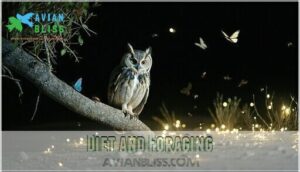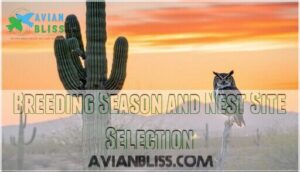This site is supported by our readers. We may earn a commission, at no cost to you, if you purchase through links.

These desert dwellers call the southwestern United States and northwestern Mexico home, nesting in saguaro cacti and abandoned woodpecker holes.
Unlike their larger cousins, elf owls hunt insects rather than mammals, snatching beetles, moths, and crickets from the air with surprising agility.
They’re strictly nocturnal, using their distinctive "puppy-like" calls to communicate across moonlit landscapes.
Despite their tiny stature, these feathered acrobats migrate seasonally and can live up to seven years in the wild.
Their remarkable adaptations reveal nature’s ingenious solutions to desert survival.
Table Of Contents
- Key Takeaways
- Elf Owl Overview
- Habitat and Distribution
- Diet and Foraging
- Behavior and Reproduction
- Conservation and Ecological Importance
- Frequently Asked Questions (FAQs)
- What does an elf owl look like?
- How does an elf owl behave when disturbed?
- What is the habitat of an elf owl?
- What is the diet of an elf owl?
- Is the Elf Owl rare?
- Can you own an Elf Owl as a pet?
- What is the difference between an Elf Owl and a pygmy owl?
- Is the elf owl rare?
- What is the name of the elf owl?
- Is the elf owl the smallest owl?
- Conclusion
Key Takeaways
- You’ll find North America’s smallest owl at just 5-6 inches tall – these tiny raptors weigh less than 1.5 ounces but pack incredible hunting skills into their sparrow-sized frames
- You can spot them in southwestern deserts where they’ve mastered nocturnal insect hunting – they use abandoned woodpecker holes in saguaro cacti as nests and catch moths, beetles, and crickets with remarkable precision
- You’ll hear their distinctive "puppy-like" calls echoing through moonlit landscapes – these strictly nocturnal birds migrate seasonally between the southwestern US and Mexico, following insect availability
- You’re witnessing nature’s pest control specialists that face real conservation challenges – while they’re crucial for controlling insect populations, habitat loss and climate change threaten their survival, with California listing them as endangered
Elf Owl Overview
You’ll find the Elf Owl (Micrathene whitneyi) holds the title as the world’s smallest owl, measuring just 5 inches tall and weighing under 2 ounces.
At just 5 inches tall, the Elf Owl proves that big things come in small packages.
This tiny raptor sports grayish-brown feathers with distinctive white "eyebrows" and pale yellow eyes that help it blend perfectly into desert environments.
Scientific Name and Classification
You’ll find this tiny raptor classified under the scientific name Micrathene whitneyi, honoring naturalist Josiah Whitney.
Bird taxonomy places it within the order Strigiformes, encompassing all owls worldwide.
The family Strigidae includes typical owls, distinguishing them from barn owls.
Classification methods rely on physical characteristics and genetic analysis for species identification, helping researchers understand evolutionary relationships within bird orders.
This taxonomic system helps researchers understand evolutionary relationships within bird orders, making the elf owl’s position in nature’s family tree crystal clear.
Size and Weight
You’ll be amazed by the elf owl’s tiny stature – this smallest owl species measures just 12-14 cm in body length with a 27-33 cm wing span.
Their weight range spans 35-55 grams, making them barely heavier than a sparrow in bird size comparison.
Despite their compact size, dense feather density provides essential insulation.
These owl facts highlight remarkable bird physical traits: females average 3% longer and 6% heavier than males, yet both sexes remain under 2 ounces, showcasing their tiny stature and compact size.
Coloration and Unique Features
Beyond its sparrow-sized frame, you’ll recognize this smallest owl by its distinctive appearance.
The grayish-brown plumage texture creates perfect desert camouflage, while white facial markings form striking "eyebrows" above pale yellow eye color.
Its compact beak shape and dense feather patterns make this nocturnal animal a master of disguise among owl species.
Key identifying features include:
- Bright yellow eyes with distinctive white eyebrow markings
- Grayish-brown plumage with white spots along wing edges
- Compact horn-tipped beak perfectly sized for catching insects
These silent flyers blend seamlessly into their surroundings, making bird identification challenging even for experienced observers.
The Elf Owl’s unique characteristics, such as its ability to fly silently, are examples of owl silent flight mechanisms that have fascinated bird enthusiasts and researchers alike.
Habitat and Distribution
You’ll find these remarkable tiny owls throughout the southwestern United States and Mexico, where they’ve mastered life in some of North America’s harshest environments.
They migrate south to Mexico each winter when insect prey becomes scarce, then return north to breed in desert landscapes dominated by towering saguaro cacti and mesquite trees.
Geographic Range and Migration
You’ll discover these tiny owls across the southwestern US and Mexico, with distinct Migration Patterns shaped by seasonal insect availability.
Northern populations migrate south each winter, while southern residents stay year-round.
Their range and distribution can be further understood by examining the owl range maps to learn more about their habitats.
| Region | Population Type |
|---|---|
| Arizona/New Mexico | Migratory breeders |
| California/Texas | Migratory (endangered CA) |
| Baja California | Year-round residents |
| Central Mexico | Wintering Grounds |
Their Geographic Distribution spans from the Mexican border through desert habitat, with Breeding Areas concentrated in Arizona’s Sonoran Desert.
This remarkable Habitat Range showcases nature’s adaptability across North America’s arid landscapes.
Preferred Ecosystems and Nesting Sites
Throughout desert habitats and thorn forests, you’ll find these tiny raptors calling abandoned woodpecker holes home.
Elf owls can’t excavate their own nesting cavities, so they depend on old woodpecker work in saguaro cactus, mesquite, and oak trees.
In riparian woodlands, they’ll nest in sycamores reaching tree canopies up to 30 feet high.
When natural options aren’t available, they’ll settle for telephone poles or nest boxes. The use of artificial owl nesting boxes can be beneficial for conservation efforts.
Adaptation to Various Environments
You’ll find elf owls showcasing remarkable Environmental Flexibility across diverse landscapes.
These adaptable nocturnal animals thrive in desert habitats, forest ecosystems, and even urban settings.
Their Ecological Resilience allows successful Desert Survival while adjusting Migration Patterns seasonally.
- Desert habitats: Nest in saguaro cacti, mesquite trees
- Forest ecosystems: Utilize oak-pine woodlands up to 5,400 feet
- Urban Adaptation: Accept telephone poles, nest boxes
- Seasonal flexibility: Adjust prey selection based on availability
Diet and Foraging
You’ll discover that elf owls are specialized insect hunters with a diet consisting primarily of moths, beetles, crickets, scorpions, and spiders.
These tiny raptors use their excellent night vision and hearing to hunt from perches, swooping down to catch prey or hovering among foliage to flush out insects, which makes them specialized hunters.
Insect Preferences and Prey
You’ll find these insectivorous owls aren’t picky eaters in the context of nocturnal foraging.
Their diet includes moths, beetles, crickets, katydids, scorpions, spiders, and centipedes. They’ll tackle scorpion prey by removing stingers before consumption.
These arthropods provide essential nutrition and water in arid environments.
Insect choices vary seasonally – moths and crickets during dry periods, beetles in wet seasons. Their prey capture abilities make them efficient hunters of various insects and small arthropods.
Foraging Methods and Techniques
You’ll witness these insectivorous night hunters employing remarkable foraging strategies that showcase their nocturnal hunting prowess.
They use a perch-and-pounce technique, sitting motionless before swooping down to capture prey. Their exceptional night vision allows precise insect hunting as they hover among foliage or strike in straight lines.
These skilled insecteaters also hunt on foot, hopping along branches while using acute hearing to locate moving insects in complete darkness.
The Elf Owl’s ability to navigate and hunt in the dark is largely due to its advanced owl night vision capabilities.
Dietary Flexibility and Seasonal Changes
Elf owls’ dietary flexibility transforms with seasonal shifts, adapting their insect hunting strategies as prey availability changes.
During spring’s dry months, moths and crickets dominate their nocturnal foraging. However, summer rains trigger dramatic prey selection changes—scarab beetles replace crickets as preferred targets.
This flexible foraging approach includes food storage in nesting cavities, ensuring survival during unpredictable periods. These skilled insecteaters demonstrate remarkable bird behavior, adjusting their bird diet seamlessly as environmental conditions shift throughout breeding seasons.
The Elf Owl’s survival is heavily influenced by its desert habitat needs, which is a critical factor in their ability to thrive in their environment, showcasing their adaptation to the ecosystem.
Behavior and Reproduction
You’ll discover that elf owls are fascinating creatures with unique nighttime behaviors and remarkable reproductive strategies.
These tiny owls use distinctive calls to communicate and follow specific patterns during their breeding season, which can be considered remarkable and involve unique nighttime activities.
Nocturnal Habits and Vocalizations
As darkness falls, you’ll discover these nocturnal hunters come alive with remarkable Night Vision and distinctive Vocal Calls.
Male Elf Owls produce puppylike barks and whistles during Nocturnal Hunting expeditions, creating unique Sound Patterns that echo through desert canyons.
Their vocalizations serve dual purposes—defending territory and attracting mates during peak Moonlight Activity.
These owls demonstrate exceptional hearing abilities, detecting the faintest insect movements in complete darkness.
Bird vocalizations vary seasonally, with males becoming especially vocal during breeding periods, utilizing their Vocal Calls to communicate effectively.
Breeding Season and Nest Site Selection
Beyond their nocturnal hunting routines, these tiny owls display fascinating breeding season behaviors that’ll make you appreciate their clever survival strategies.
Breeding season typically runs from April through June, when males become incredibly vocal to establish territories and attract mates. Their courtship involves persistent nighttime calling, often described as puppylike barks that echo through desert canyons. Males demonstrate their commitment by bringing food gifts to potential partners.
Nest site selection follows specific criteria:
- Recycled woodpecker holes in saguaro cacti, mesquite, oak, or sycamore trees
- Height preferences ranging from 10 to 30 feet above ground for predator protection
- Cavity size must accommodate their small bodies while providing adequate shelter
- Proximity to hunting grounds with abundant insect populations nearby
Egg Laying and Incubation
Once you’ve secured that perfect nesting site, the female elf owl begins her egg formation process.
She’ll typically lay three white eggs, though clutches can range from two to four.
The incubation period lasts approximately 24 days, with the female handling all incubation duties while her mate provides food.
This dedicated nesting behavior supports proper fledgling care, as the male’s hunting supports both his partner and their future offspring during these vital breeding habits.
Understanding hormonal changes is essential for recognizing egg laying signs in birds.
Conservation and Ecological Importance
You’ll find that despite their small size, elf owls play a vital role in controlling insect populations across southwestern ecosystems.
While their conservation status remains relatively stable, habitat loss from development and climate change poses growing threats to these remarkable tiny raptors.
Population Trends and Threats
You’d be alarmed to learn that elf owl populations are crashing across their range.
These tiny raptors face a perfect storm of challenges threatening their survival:
- Habitat Loss from urban development and agriculture destroys nesting sites
- Climate Change and droughts reduce insect prey availability
- Human Impact through water diversion degrades riparian woodlands
- Population Decline documented at 24% over recent decades
With only 72,000-200,000 individuals worldwide, this endangered species needs immediate attention.
Protection Efforts and Conservation Status
Several conservation initiatives safeguard elf owls through targeted Wildlife Management and Environmental Policy.
California lists them as "endangered," while globally they’re "Least Concern."
The Lower Colorado River Multi-Species Conservation Program balances water use with habitat needs.
Conservation efforts often rely on specialized Owl Conservation tools and strategies.
| Conservation Status | Protection Level |
|---|---|
| California | Endangered |
| Global (IUCN) | Least Concern |
| Federal | Species of Concern |
| Population |
Role in Ecosystem and Interactions With Other Species
You’ll find elf owls playing an essential role in desert ecosystems through complex species interactions. These nocturnal hunters maintain ecosystem balance by controlling insect populations, preventing agricultural pest outbreaks.
Their predator prey relationships demonstrate fascinating adaptations – they’ll carefully remove scorpion stingers before eating! Meanwhile, larger raptors like great horned owls keep elf owl populations in check, creating natural food chains that support biodiversity.
Conservation efforts focusing on bird species preservation are essential for protecting these owls and their habitats.
- Insect Control: Elf owls consume thousands of moths, beetles, and crickets annually, naturally managing pest populations in desert ecosystems
- Cavity Competition: They compete with woodpeckers and other birds for nesting sites, influencing local bird community structure and habitat use
- Predator Avoidance: Great horned owls, snakes, and mammals prey on elf owls, creating multi-level food chains essential for biodiversity role
- Symbiotic Relationships: Blind snakes in nests eat parasites, improving chick survival rates through unique species interactions
- Ecosystem Indicators: Their presence signals healthy desert ecosystems, making bird conservation efforts important for maintaining natural balance
Frequently Asked Questions (FAQs)
What does an elf owl look like?
Imagine this tiny warrior from medieval times – you’d spot an elf owl’s sparrow-sized frame covered in grayish-brown feathers with distinctive white spots.
You’ll notice its pale yellow eyes, white "eyebrows," and compact 5-inch body weighing under 2 ounces, which is a notable feature of this tiny creature, with its distinctive white spots.
How does an elf owl behave when disturbed?
When you disturb an elf owl, it’ll freeze motionless, relying on its camouflage to blend with tree bark. If threatened further, it’ll fly silently to another hiding spot nearby.
What is the habitat of an elf owl?
Where do these tiny raptors call home?
You’ll find elf owls thriving in southwestern deserts, thorn forests, and riparian woodlands from Arizona to Mexico.
Nesting in old woodpecker holes in saguaro cacti and oak trees.
What is the diet of an elf owl?
You’ll discover that elf owls are primarily insectivorous, feeding on moths, beetles, crickets, scorpions, spiders, and centipedes.
They hunt nocturnally, catching prey with their feet and occasionally removing scorpion stingers before eating.
Is the Elf Owl rare?
The conservation status isn’t dire globally, but you’ll find this tiny raptor listed as endangered in California with fewer than 150,000 individuals remaining nationwide.
Can you own an Elf Owl as a pet?
No, you can’t legally own an Elf Owl as a pet. They’re protected under federal law, requiring special permits for wildlife rehabilitation or research only.
What is the difference between an Elf Owl and a pygmy owl?
You’ll notice pygmy owls are diurnal hunters while elf owls are strictly nocturnal. Pygmy owls also lack the distinctive white "eyebrows" that make elf owls so recognizable in desert habitats.
Is the elf owl rare?
Like a small treasure hidden in desert shadows, you’ll find this tiny owl isn’t exactly rare but faces real challenges.
They’re declining in some areas due to habitat loss, yet they’re still widespread across southwestern deserts and Mexico’s thorn forests.
What is the name of the elf owl?
You’ll find the elf owl’s scientific name is Micrathene whitneyi, also called Whitney’s Owl.
This tiny raptor earned its common name from its sparrow-like size, making it the world’s smallest owl species.
Is the elf owl the smallest owl?
Despite common misconceptions about size variations among owl species, you’ll find that the elf owl (Micrathene whitneyi) is indeed the world’s smallest owl.
Weighing just 4 ounces and measuring 5 inches long, it’s barely larger than a sparrow.
Conclusion
Picture a tiny sentinel perched against the star-studded desert sky, its enormous eyes scanning for prey among the cacti.
You’ve discovered how the elf owl proves that size doesn’t determine survival success. These remarkable birds have mastered desert life through specialized hunting techniques, strategic nesting choices, and perfectly-timed migrations.
Their insect-focused diet and nocturnal habits showcase nature’s incredible adaptability. By protecting their fragile desert habitats, you’re ensuring future generations can witness these miniature marvels continuing their ancient dance under moonlit southwestern skies.











